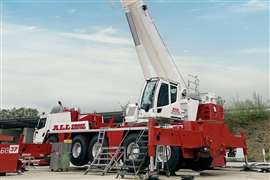British concern despite good figures
17 March 2014
The seasonally-adjusted estimate of Great Britain’s construction output in January 2014 rose in comparison with December 2013, but with infrastructure output falling, industry watchers are expressing concern despite the positive signs.
Estimates from the Office for National Statistics (ONS) suggested that construction output in January 2014 had risen by 1.8% – £170 million (€203.4 million) when compared with December 2013. There was a slight rise of 0.8% – £50 million (€59.8 million) – in new work, and a larger increase of 3.5% – £120 million (€143.6 million) – in repair and maintenance.
The ONS found that longer-term comparisons showed an improved picture of construction output. All work in January 2014 increased 5.4% – £490 million (€586.5 million) – when compared with January 2013. It said a similar story was apparent across the different types of work, where new work had increased by 5.9% – £330 million (€395 million) – and repair and maintenance by 4.5% – £160 million (€191.5 million) – over the same period.
Dr Noble Francis, economics director at the UK’s Construction Products Association, warned, however, “Despite many government announcements of finance for large infrastructure projects over the last two years, output in the infrastructure sector fell by 2.3% in January compared with December, and was 3.2% lower than a year earlier.”
He added, “Of greater concern, infrastructure new orders in the fourth quarter were 22.2% lower than in the third quarter. Therefore, it is vital that the government focuses on delivery of existing projects in the pipeline rather than further announcements.”
Output is defined by the ONS as the amount charged by construction companies to customers for value of work (produced during the reporting period) excluding VAT and payments to sub-contractors.
New orders for construction in the fourth quarter of 2013 are estimated to be 1.5% higher than the third quarter as a result of a 5.2% – £200 million (€239.5 million) increase in orders for new housing. All other work fell 0.4% over the same period, caused by the 22.2% – £590 million (€706.4 million) – decrease in orders for infrastructure.
The ONS said the construction output estimates were a short-term indicator of construction output by the private sector and public corporations within Great Britain, and are produced from a monthly survey of 8,000 businesses.
Persistent storms
It said that persistent storms and rainfall during January had affected construction businesses, but that qualitative evidence emerging from its survey data collection suggested that effects had been localised. It concluded that some types of work might have decreased as new work could not be completed. However, there may have been additional repair and maintenance required in these areas, it said.
Dr Francis said, “New orders are an early indicator of future output, so the 1.5% rise during the final quarter of 2013 suggests that the growth in activity is also likely to continue over the next 12 to 18 months.”
He said, “Private housing was the key driver of construction growth in January with sector output 23.3% higher than a year earlier. New orders for private housing in the fourth quarter rose 7.2% compared with the third quarter, and indicate growth for the sector in 2014 and 2015.
“The Association forecasts that private housing starts will rise 16% this year and a further 10% in 2015,” he added.
“Output in public non-housing, which primarily covers schools and hospitals work, has suffered greatly in recent years but looks set for a recovery. Output in the sector fell 34% between 2010 and 2013. In January, however, output was 2.2% higher than a year earlier and new orders in the fourth quarter were 16.8% higher than in the third quarter, pointing towards sector growth this year.”
Paul Connolly, managing director of cost management at the global construction consultancy Turner & Townsend, said, “The recovery is real – but dotted with caveats. Such mixed data neatly illustrate both the strengths and the weaknesses of the construction industry's progress.”
He said the headline figures were impressive, with total output now £500 million (€598.7 million) higher than at the same time last year.
“And the overall pipeline picture is rosy – new orders in the last quarter of 2013 were up 1.5% over the previous three months.”
He was concerned, however, that much of this growth was heavily focused on housebuilding.
“Outside the buoyant residential sector – which is up by a truly remarkable 35% in a year,” he said, “things are much less encouraging.
“The regional picture remains patchy too. The North/South divide continues, and outside London much of the growth is concentrated on the university and learning hubs, where lack of supply risks driving up input prices.”
He said that while the boom in housebuilding said much about consumer confidence, the “continued stagnation in infrastructure” was a worry.
“The £100 billion (€119.7 billion) promised in last year's Spending Review won't begin to flow into UK infrastructure for another year.
“It's great that the industry is responding to the surging demand for homes,” said Connolly. “But until the funding environment for infrastructure projects improves, construction will struggle to fulfil its full potential as an engine of growth for the wider economy.”






